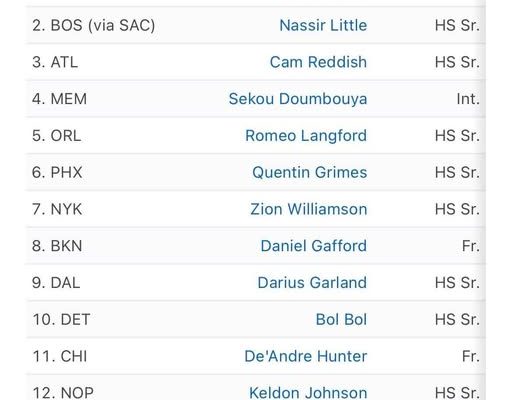The New York Knicks have often been the subject of basketball debates for their roster decisions, draft picks, and long-term vision, but one of the more overlooked storylines in recent memory is the rare convergence of three former top-six high school recruits—RJ Barrett, Cam Reddish, and Quentin Grimes—on their roster at the same time. For a franchise that has historically struggled with developing and retaining elite talent, the simultaneous presence of Barrett, Reddish, and Grimes represented a unique and potentially transformative alignment of young pedigree. Yet, instead of blossoming into a new homegrown core or forming the foundation of a long-term plan, that trio became another example of talent mismanagement, fit issues, and timing that just didn’t click.
RJ Barrett, selected third overall in the 2019 NBA Draft, was the face of the Knicks’ rebuild at the time. He was a consensus top-three recruit coming out of Montverde Academy and widely considered the top player in his high school class before Zion Williamson stole the national spotlight during their time together at Duke. Barrett came into the NBA with a mix of offensive polish and relentless work ethic. His scoring ability, size for the wing, and willingness to shoulder big moments made him a cornerstone-type player in the eyes of the Knicks’ front office. His rookie year had flashes of promise, followed by a strong sophomore campaign in which he upped his three-point percentage to 40%, earning respect for his growth. By the time Cam Reddish entered the picture, Barrett was already seen as a foundational piece and face of the franchise’s future.
Cam Reddish’s path to New York was a little more winding. Drafted 10th overall by the Atlanta Hawks in the same 2019 class as Barrett, Reddish was also a top-three high school recruit—ranked even higher than Zion in some early 2018 evaluations. His silky jumper, prototypical frame for a wing, and potential as a two-way force were tantalizing. However, inconsistency plagued him in Atlanta. Whether it was his shot selection, injuries, or simply the presence of too many mouths to feed on a young, playoff-contending Hawks squad, Reddish never quite carved out a dependable role. That didn’t diminish his perceived upside, though, and in January 2022, the Knicks pounced. They traded Kevin Knox and a first-round pick to bring Reddish to New York—reuniting him with Barrett and adding a highly skilled, if underperforming, piece to their puzzle.
Then there was Quentin Grimes. The least heralded of the three coming out of college, but ironically, the highest ranked in high school among the trio. Grimes was ranked as high as No. 4 in the nation coming out of high school, right up there with Barrett and Reddish. Originally committed to Kansas, Grimes had a rocky freshman year before transferring to the University of Houston, where he completely reinvented himself. In Houston, Grimes became a gritty two-way guard with excellent shooting range and a hard-nosed mentality. When the Knicks drafted him late in the first round in 2021, most assumed he’d be a role player at best. But Grimes proved his mettle quickly. His commitment to defense, willingness to do the little things, and unselfish offensive game endeared him to coach Tom Thibodeau almost immediately. Within a year, he was getting serious minutes and becoming a glue guy in a rotation that needed reliability.
For a brief period in 2022, the Knicks had RJ Barrett, Cam Reddish, and Quentin Grimes on their roster. Three top-six high school prospects. Three former blue-chip stars who once carried enormous expectations into their college and NBA careers. On paper, it looked like a dream scenario—a versatile, switchable wing trio with offensive upside and defensive potential. Barrett was the scoring wing who could create. Reddish had the length and skill to be a dangerous two-way threat. Grimes had the motor and shooting touch to complement any lineup. They were all under 25, theoretically moldable into a homegrown unit that could develop chemistry and provide the Knicks with cap flexibility, continuity, and talent all at once. But as Knicks fans have learned far too often, potential doesn’t guarantee production—or opportunity.
The biggest issue was fit—not just on the floor, but with the coaching philosophy and organizational priorities. Tom Thibodeau is known for favoring dependable veterans and players who embrace his defensive principles without hesitation. Barrett fit this mold to some degree, especially given his improving defense and status as a starter. Grimes, with his hustle, defensive IQ, and shooting efficiency, also gained Thibodeau’s trust quickly. Reddish, however, struggled to fit the Thibs archetype. His game—smooth, somewhat aloof at times, and reliant on rhythm—clashed with Thibodeau’s more rigid structure. His defensive lapses, inconsistency, and what was perceived as a lack of urgency made it hard for him to break into the regular rotation. In some games, he’d flash his potential: a silky 17-point night with lockdown defense, only to follow it up with two games of invisibility. Thibodeau had little patience for that kind of variance.
In truth, Reddish was never fully given the leash to develop under Thibodeau. Despite showing sparks in limited minutes, he was often buried on the bench or relegated to garbage time. There were stretches when injuries forced the Knicks’ hand and Reddish got legitimate minutes—only to be pulled after a missed defensive assignment or poor transition coverage. The Knicks front office seemed divided on him too. Bringing him in at the cost of a first-round pick showed investment, but not playing him undermined that move. By the time trade rumors swirled again in early 2023, it was clear Reddish wasn’t going to be part of the Knicks’ future. He was eventually shipped off to Portland as part of the Josh Hart deal—a player Thibodeau trusted and used heavily right away.
The irony of it all is that Reddish may have been the most talented of the three in terms of raw ability. His frame, handle, and fluidity were rare for a player his size. But the intangibles—focus, consistency, motor—were lacking at critical moments. Meanwhile, Grimes and Barrett were more coachable, more stable in their development trajectories, and more aligned with the Knicks’ evolving identity as a gritty, defensive-minded squad.
Another issue was usage. Barrett often handled the ball or was tasked with initiating offense alongside Jalen Brunson. Grimes was almost entirely off-ball, spacing the floor and defending top wings. Reddish was a tweener—neither a primary creator nor a true role player. He needed touches to find rhythm, but he wasn’t going to get them consistently behind Barrett, Brunson, and Julius Randle. The Knicks were too deep at his position and not committed enough to his development.
If one were to wonder what might have been had a different coach been in charge—one more tolerant of youthful mistakes and capable of empowering all three—it’s not far-fetched to believe the Knicks could have reaped the benefits of letting that trio grow together. Imagine a world where Reddish and Grimes shared the wings, with Barrett sliding into a secondary playmaker role. The defensive switchability, offensive creation, and perimeter spacing could have been elite with proper chemistry and patience. But the Knicks weren’t built to be patient. They were—and still are—trying to contend, to claw into the upper echelon of the East. That urgency, while understandable, came at the cost of development.
It’s not uncommon for NBA teams to bring together highly-touted former prospects, but it’s rare to have three of the top six recruits from the same high school class on one roster. The Knicks managed it, however briefly. But as with many Knicks chapters over the last two decades, it became a story of what could’ve been. Grimes is still around, still developing, and likely has a long-term role as a 3-and-D starter or sixth man. Barrett was traded to the Raptors in the OG Anunoby deal, a move that many saw as a necessary shift in team construction but one that still stung given how much he represented the rebuild. Reddish has since bounced around, a journeyman whose promise remains unfulfilled, a reminder that talent alone isn’t enough in the league without opportunity and trust.
In retrospect, the Knicks’ brief experiment with this trio says a lot about how talent evaluation and development often diverge in the NBA. Having the talent is one thing. Getting the most out of it—especially within a rigid coaching system, impatient media environment, and evolving front office agenda—is another. Barrett, Reddish, and Grimes each had moments, but the synergy that could have come from building around all three was never fully pursued. It may go down as a trivia tidbit for NBA nerds or a minor footnote in Knicks history, but for a team that has long been chasing star power and continuity, the simultaneous presence of three former top-six national recruits is a reminder that sometimes, the right pieces show up—but the timing, the system, or the vision just isn’t there to make it work.



